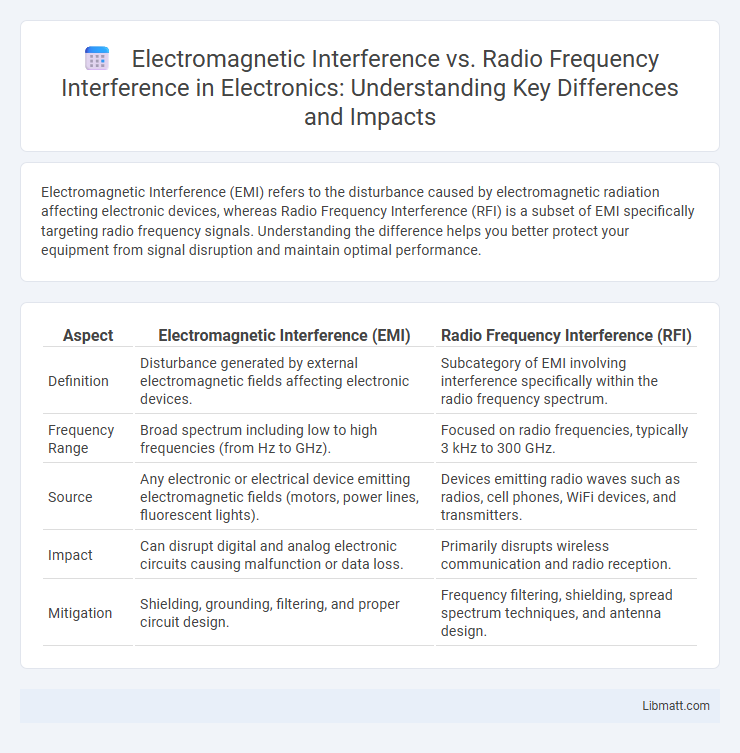Electromagnetic Interference (EMI) refers to the disturbance caused by electromagnetic radiation affecting electronic devices, whereas Radio Frequency Interference (RFI) is a subset of EMI specifically targeting radio frequency signals. Understanding the difference helps you better protect your equipment from signal disruption and maintain optimal performance.
Table of Comparison
| Aspect | Electromagnetic Interference (EMI) | Radio Frequency Interference (RFI) |
|---|---|---|
| Definition | Disturbance generated by external electromagnetic fields affecting electronic devices. | Subcategory of EMI involving interference specifically within the radio frequency spectrum. |
| Frequency Range | Broad spectrum including low to high frequencies (from Hz to GHz). | Focused on radio frequencies, typically 3 kHz to 300 GHz. |
| Source | Any electronic or electrical device emitting electromagnetic fields (motors, power lines, fluorescent lights). | Devices emitting radio waves such as radios, cell phones, WiFi devices, and transmitters. |
| Impact | Can disrupt digital and analog electronic circuits causing malfunction or data loss. | Primarily disrupts wireless communication and radio reception. |
| Mitigation | Shielding, grounding, filtering, and proper circuit design. | Frequency filtering, shielding, spread spectrum techniques, and antenna design. |
Introduction to Electromagnetic and Radio Frequency Interference
Electromagnetic Interference (EMI) refers to disturbances generated by electromagnetic fields affecting electronic devices, while Radio Frequency Interference (RFI) is a subset of EMI that specifically involves disruptions within radio frequency bands. Both EMI and RFI can degrade the performance of your electronic equipment by causing signal loss, noise, or malfunction. Understanding the sources and characteristics of EMI and RFI is essential for implementing effective shielding and filtering techniques to protect sensitive electronics.
Defining Electromagnetic Interference (EMI)
Electromagnetic Interference (EMI) refers to the disruption caused by electromagnetic fields emitted from electronic devices that affect the performance of nearby equipment. EMI encompasses a broad range of frequencies and sources, including motors, power lines, and wireless transmissions, which can induce unwanted signals and noise. Understanding EMI is crucial to protect your electronic systems from unintended disturbances that degrade functionality and reliability.
Understanding Radio Frequency Interference (RFI)
Radio Frequency Interference (RFI) is a specific type of Electromagnetic Interference (EMI) that affects wireless communication by disrupting radio signals. RFI originates from various sources such as electronic devices, power lines, and natural phenomena, causing signal degradation or loss in radios, televisions, and wireless networks. Identifying and mitigating RFI involves techniques like shielding, filtering, and proper grounding to maintain signal integrity and prevent communication failures.
Key Differences Between EMI and RFI
Electromagnetic Interference (EMI) and Radio Frequency Interference (RFI) both disrupt electronic devices but differ primarily in scope and frequency range. EMI covers a broad spectrum of electromagnetic disturbances, including low-frequency noise from power lines and high-frequency signals, whereas RFI specifically refers to interference within radio frequency bands, typically between 3 kHz and 300 GHz. Understanding these distinctions helps you diagnose and mitigate interference issues more effectively in communication and electronic systems.
Sources of Electromagnetic Interference
Sources of Electromagnetic Interference (EMI) include natural phenomena like lightning, solar flares, and static electricity, as well as man-made devices such as electric motors, power lines, fluorescent lights, and switching power supplies. Electrical equipment that generates rapidly changing magnetic and electric fields often contributes to EMI, disrupting nearby electronic circuits. Understanding these sources helps you mitigate interference in sensitive communication and control systems.
Common Sources of Radio Frequency Interference
Common sources of Radio Frequency Interference (RFI) include wireless communication devices, microwave ovens, and fluorescent lighting, which emit unwanted signals disrupting electronic equipment. Other significant contributors are power lines, broadcast transmitters, and industrial machinery that generate high-frequency noise. Understanding these sources helps protect your devices from performance degradation caused by Radio Frequency Interference.
Impact of EMI and RFI on Electronic Devices
Electromagnetic Interference (EMI) and Radio Frequency Interference (RFI) cause significant disruptions in the performance of electronic devices by inducing unwanted noise and signal distortion. EMI can degrade the functionality of sensitive components such as microprocessors and communication systems, leading to data corruption and operational failures. RFI, a subset of EMI within radio frequency bands, specifically affects wireless communication devices by causing signal loss, reduced sensitivity, and intermittent connectivity issues.
Detection and Measurement of EMI and RFI
Detection and measurement of Electromagnetic Interference (EMI) and Radio Frequency Interference (RFI) require specialized instruments such as spectrum analyzers and EMI receivers that identify signal disturbances across specific frequency ranges. EMI detection focuses on a broader spectrum, including conducted and radiated emissions, while RFI measurement targets interference within the radio frequency bands affecting wireless communication systems. Your ability to accurately assess EMI and RFI is enhanced by using calibrated sensors and adhering to standard testing procedures set by regulatory bodies like the FCC and CISPR.
Mitigation Techniques for EMI and RFI
Mitigation techniques for Electromagnetic Interference (EMI) and Radio Frequency Interference (RFI) include shielding using conductive materials, grounding to dissipate unwanted signals, and filtering with capacitors and inductors to block noise frequencies. Implementing twisted pair cables and maintaining proper layout design reduces coupling and crosstalk, which are common sources of EMI and RFI. Advanced solutions such as ferrite beads and surge protectors help in minimizing transient disturbances and preserving signal integrity in sensitive electronic systems.
Future Trends in EMI and RFI Management
Advancements in EMI and RFI management increasingly leverage adaptive filtering and machine learning algorithms to detect and mitigate interference in real-time, enhancing wireless communication reliability. The integration of metamaterials and nanotechnology in shielding solutions offers unprecedented improvements in electromagnetic compatibility for next-generation devices. Industry standards like CISPR and IEEE are evolving to address emerging frequency bands in 5G and IoT, promoting robust EMI/RFI mitigation strategies across diverse electronic ecosystems.
Electromagnetic Interference vs Radio Frequency Interference Infographic

 libmatt.com
libmatt.com